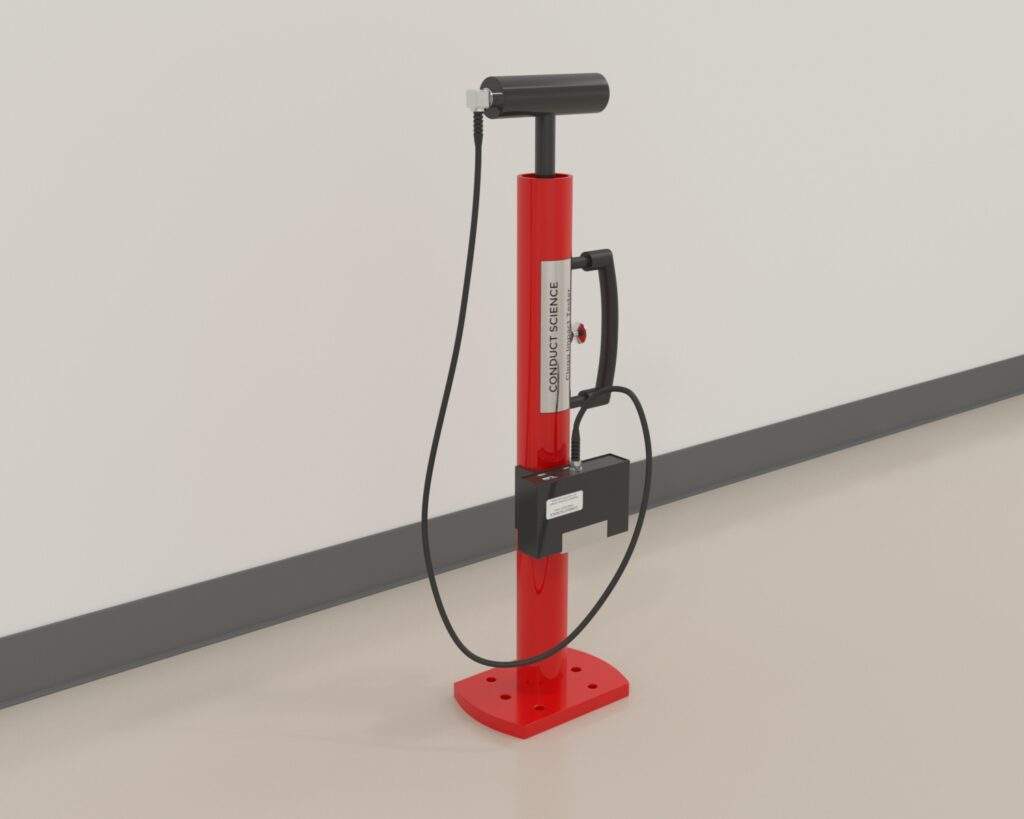

Reference to this article: ConductScience, Ultimate guide on Clegg Impact Testers (2022). doi.org/10.55157/CS20220727
Clegg Impact Tester, also known as Clegg Hammer or Clegg Impact Hammer, is a portable device used to determine a surface’s shock absorption and bearing capacity. It is used to measure and control the strength of soils, aggregates, and synthetic materials for sports surfaces and roads.
The device is named after its inventor, Dr. Baden Clegg, and is used to relate the surface’s ability to withstand the structural load put upon the surface. It also allows users to determine on-site, the strength, stiffness, and stability of the testing surface, and whether it meets relevant standards.[1]

Figure: Clegg Impact Tester
The main components of the Clegg Impact Tester are:[1]
A compaction hammer is a standard mass dropped to the surface from a specific vertical distance. The impact of the compaction hammer on the testing surface produces the deceleration of the mass, which is recorded in gravities (g) or Clegg Impact (CIV or IV) One CIV unit is equal to 10 gravities.
The original standard hammer is 4.5g, designed to determine the quality of road-building materials such as crushed rocks, laterite gravel, sandstone, and fine sand. Nowadays, the mass of the compaction hammer can be medium (2.25kg), lite (0.5kg), and heavy (10 or 20kg), enabling users to apply the device to various applications.[1,2]
A guiding tube is a self-standing cylindrical tube of a specific height providing the standard drop height and allowing users to compare data from several measurements. The current standard height of the guiding tube is 45 centimeters.
A piezoelectric accelerometer is attached to the compact hammer to measure the deceleration values of the free-falling compaction hammer. Considered the heart of the Clegg Impact Tester, the accelerometer displays the maximum (peak) deceleration or G-max.
The value helps to calculate additional values such as total impact duration, maximum deceleration duration, average deceleration, surface deformation, and rebounding time. These give users a comprehensive picture of the surface and its base materials characteristics.[3]
The original Clegg Hammer has an analog gauge, showing the values measured by the accelerometer. However, the analog gauge often needs resetting to zero before taking a new measurement. Most Clegg Impact Testers nowadays come with a digital display that comes with an auto-zero function and houses a control unit that provides additional functions.[2]
Asides from the three main components, Clegg Hammers may also have other components that add to their functionality and user’s convenience. For example, a combined vibration analyzer- Clegg Impact Tester can generate the deceleration curve over time.
A GPS, hard disk drive, and Bluetooth device can be added to the Clegg Impact Testers so that users can record positioning data and download them to other devices for further analysis.[3]
The Clegg Impact Hammers are portable and easy to use. Users do not need specialized training to use the device and obtain accurate measurements. Nonetheless, a technical understanding of the relevant application is generally required to interpret and follow up on the data obtained from the measurements.
Follow these steps to obtain the strength of the surface using a Clegg Impact Tester:
Typically, an assessment by a Clegg Impact Tester is performed several times on the surface of interest. The measurements are repeated on the same spot and performed on other spots on the surface of interest. The number of repeats and spots per area is usually provided in standardized methods for using Clegg Impact Hammers on surfaces subjected to specific regulations.
Since its conception, Clegg Impact Testers have been used for in situ quality control of the following:
The base courses and construction foundations are the original subjects of the Clegg Impact Testers. They were first measured by imposing a series of 4.5kg-Clegg Hammer to the surface until acquiring a constant impact value.
Since then, the compaction hammer mass has been increased to 10kg and 20kg, allowing the Clegg Hammer to test thicker surfaces with multiple layers, such as flexible pavement and gravel road beds.[1-2]
The Clegg Impact Tester measures the impact value of natural and artificial turfs meant for outdoor activities like playgrounds and sporting events. The resulting values are used to estimate the hardness and firmness of the turf and whether it is safe if children or players fall onto the turf. Most turfs are measured by a Clegg Impact Tester with a medium (2.25kg) compaction hammer.[2]
Similar to turfs, the hardness and firmness of an athletic track and surface are evaluated by a medium-mass Clegg Impact Tester. Hard surfaces can pose acute or repetitive strain injuries to human and equine athletes who regularly train and compete on them.[4]
The softness of the stall base and surface plays a significant role in the health and welfare of stall animals. For instance, comfortable stalls can encourage dairy cows to spend more time lying down, increasing their blood flow and milk production.
In this case, a heavy Clegg Impact Tester with a 10kg compaction hammer is used to appraise the suitability of the stall base and assess whether and how much bedding materials should be added to increase the cow’s comfort.[5]
In general, Clegg Impact Testers are straightforward, portable, and durable. Here are some factors to consider when purchasing one:
A Clegg Impact Tester is a device that measures the impact of its free-falling compaction hammer on the surface of interest. The resulting deceleration values enable users to assess the capacity of the surface to bear structural loads and absorb shock impact on-site.
In other words, the Clegg hammer is used to measure and control the strength of soils, aggregates, and synthetic materials for sports surfaces and roads. It consists of a hammer, a tube that guides the hammer, and an accelerometer mounted on the hammer.
It is an easy-to-use device that can accommodate various applications, depending on the size of the compaction hammer. If you need to assess the hardness of turfs and athletic tracks, check out our Clegg Impact Tester with a medium-sized compaction hammer!
